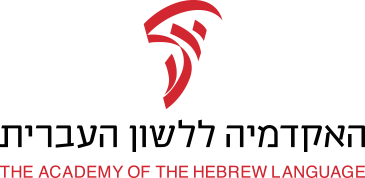Our history begins with our predecessor, the Language Committee, whose work we continue today. By the time the Academy was established in 1953, Hebrew was already the accepted lingua franca of the Jews in Israel, thanks to decades of concerted effort to revive and propagate spoken Hebrew. The Language Committee played an important role in that extraordinary endeavor.
The Work of the Language Committee
The Language Committee arose initially at the end of the 19th century as an offshoot of Safa Brura, an organization founded in 1889 by Eliezer Ben-Yehuda (1858–1922, scholar and journalist) and some of his Jerusalem associates to promote Hebrew speech and to establish Hebrew as the accepted language of the Yishuv, the Jewish community in the Land of Israel. (The phrase safa brura appears in Zeph. 3:9, where it is often translated “a pure language.”) Although Hebrew had remained in use in sacred contexts continuously since antiquity, it had last served as a language of day-to-day speech centuries earlier, so it lacked words for many basic things. Conducting lessons in Hebrew required schoolteachers to improvise Hebrew words, and as a result terminology differed from one school to the next. To address the need for Hebrew words and establish a shared vocabulary, Safa Brura formed a committee led by Ben-Yehuda to scour Hebrew literature and publish Hebrew words – resurrected or repurposed from the literature, newly coined, or adapted from Arabic – for adoption by the public. This committee, initially called Va'ad HaSifrut, the Literature Committee, soon changed its name to Va'ad HaLashon, the Language Committee. Safa Brura and its Language Committee disbanded in 1891 but had laid the groundwork for future efforts of this kind.
In the summer of 1904 the Language Committee was reestablished at the initiative of the Teachers’ Union (then called the Teachers’ Association in the Land of Israel), which wanted to make Hebrew the language of instruction and common speech in schools and felt an urgent need for a body to guide the process of coining Hebrew words and terms for use by the teachers. The reconstituted Language Committee began convening the following winter. Its seven members included both Hebrew scholars from Jerusalem and linguistically erudite members of the Teachers’ Union: Ben-Yehuda – president; H̱ayyim Arye Zuta (1868–1939, Hebrew educator and writer) – secretary; David Yellin (1864–1941, Hebrew educator and scholar); Dr. Aharon Me'ir Masie (1858–1930, physician and medical lexicographer); Joseph Meyouhas (1868–1942, educator and writer); Eliyahu Sappir (1869–1911, Hebrew educator); Rabbi Yeẖi'el Mikhl Pines (1843–1913, writer and Zionist activist). Abraham Moses Luncz (1854–1918, scholar, writer, publisher) joined around 1907.
The Language Committee in its early years faced numerous difficulties, including internal disagreements, lack of funding (which restricted the frequency of its meetings and the pace of its work), and challenges to its authority. Some critics contended that the Language Committee should consult with scholars from abroad; others, frustrated with its slow pace, attempted to form complementary or competing bodies. In 1911, Aẖad Ha'Am (pen name of Asher Ginzberg, a leading Zionist thinker) intervened, convening representatives of three bodies: the Language Committee, the Committee for the Expansion of the Language that had arisen of late in Jaffa, and the Teachers’ Union. The meeting’s participants agreed to grant the Language Committee final authority over terminology and to dissolve the Jaffa committee, and the representatives of the Teachers’ Union promised support and funding for the Language Committee’s work. Still, disagreements persisted.
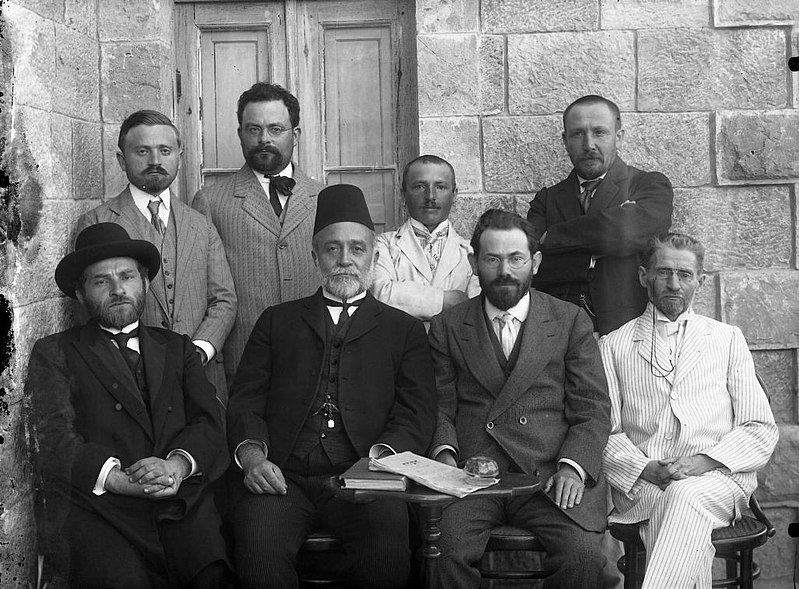
Members and close associates of the Language Committee, 1912.
From 1912 to 1928 the Committee published six booklets of minutes, Zikhronot Va'ad HaLashon (in Hebrew), containing lectures, discussions, decisions, and lists of new Hebrew terms (until then Ben-Yehuda had published the Committee’s new Hebrew terms in his newspapers). For instance, the Committee debated which pronunciation of the letters and vowels should become standard in modern spoken Hebrew and negotiated principles for adopting new Hebrew terms. The lists of terms in the Zikhronot provided everyday vocabulary for domestic, educational, and vocational contexts, on topics ranging from foods and cooking utensils, garments, and furnishings to mathematics, geography, construction, carpentry, and leatherwork, as well as a list of plant names and vocabulary for kindergarten teachers and for physical-education instructors.
World War I scattered the Committee members around the world, interrupting their work. After the British conquest of the Holy Land, the Committee reassembled and resumed its activity with vigor, adding members and increasing the frequency of the meetings. The Committee considered a proposal to strengthen and expand its activities and turn it into an institute for Hebrew research, whose academic work would underlie the innovation of terms and other linguistic decisions; for a time, the Committee even changed its name to Midrash HaLashon, the Language Institute.
The Language Committee took part in negotiations with the British Mandatory authorities about recognition of Hebrew as an official language, demanding for Hebrew equal status with Arabic. The demand reflected the linguistic transformation the Yishuv and the adoption of Hebrew as the national language of the Jewish settlement and its institutions. The Language Committee helped facilitate this shift, providing answers and advice to Yishuv bodies that sought to conduct their activities in Hebrew.
With the death of Ben-Yehuda at the end of 1922, the Committee lost a most vital member, and its activities stalled for a while. In 1924 it got a boost when H̱ayyim Naẖman Bialik, the “national poet,” moved to the Holy Land and joined the Committee’s ranks; he contributed tremendously to the work on Hebrew terms and personally coined many Hebrew words that caught on, such as מָטוֹס (‘airplane’), מַצְלֵמָה (‘camera’), and תְּגוּבָה (‘reaction’).
In 1926 the Language Committee more than doubled in size and distributed the terminology task among the members, setting up multiple subcommittees to work in parallel on different topics – geography, construction, household furnishings and foods, craftsmanship (machinery, tools, etc.), and agriculture – in collaboration with relevant professionals. This work model remains in use today in the preparation of new lists of professional terms.
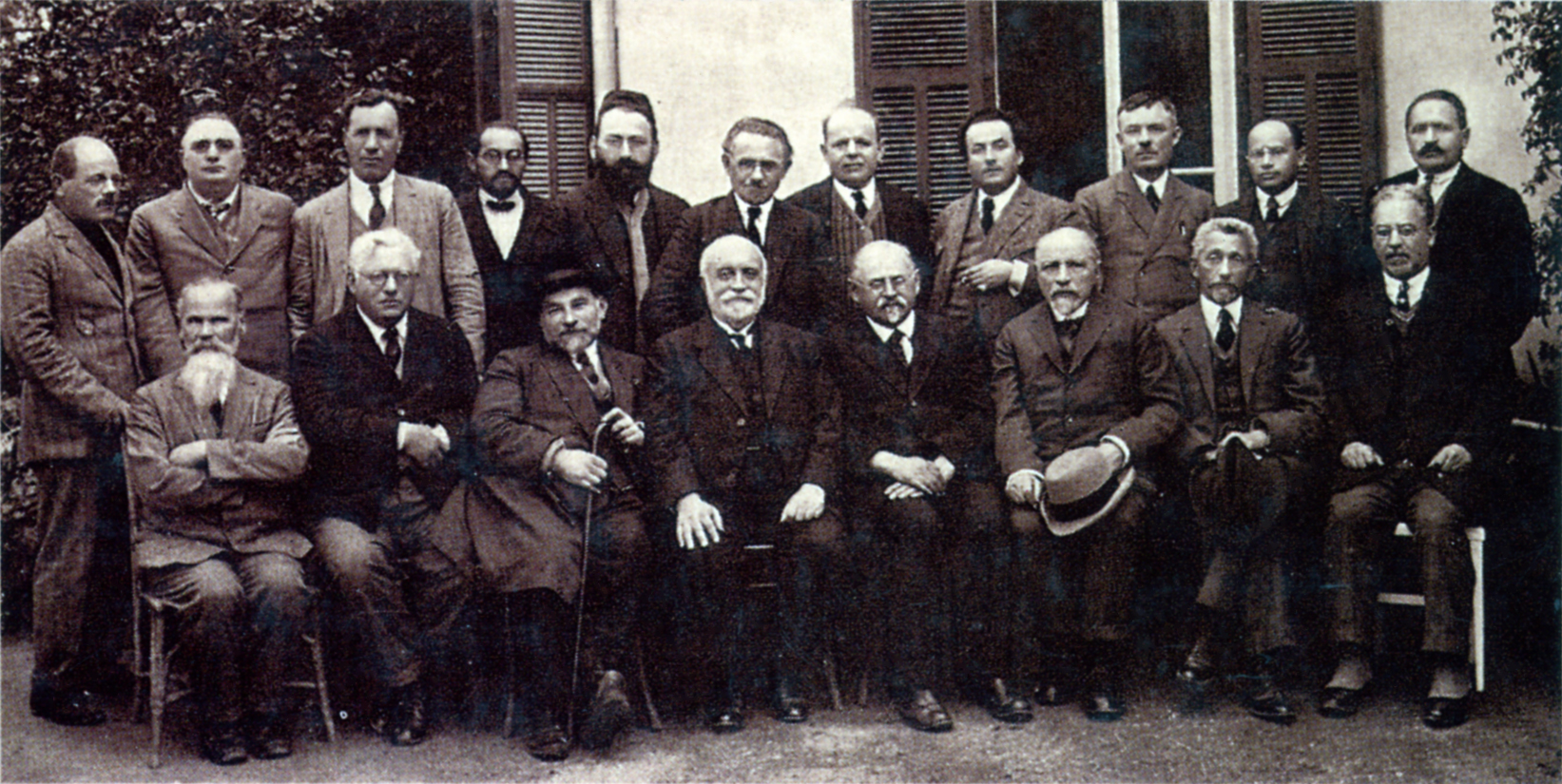
The Language Committee in 1927. לפרטים
In 1928 the Language Committee published the sixth and last volume of Zikhronot and established Lešonenu, a quarterly academic journal on the Hebrew language. From then on, the Committee reported on its activities in Lešonenu and published its Hebrew terms either as lists in Lešonenu or as separate printed dictionaries (books or booklets).
In the years that followed, the Language Committee formed a subcommittee to address common Hebrew errors and to field questions from the public, as well as subcommittees dedicated to issues of spelling, punctuation, and more. As preparations for the establishment of the State of Israel progressed, the Language Committee contributed its expertise, providing Hebrew legal and governmental terms. By this time the Language Committee had an active, well-established branch in Tel-Aviv and also a subcommittee for technical terms operating in Haifa in cooperation with the Technion. Still, Jerusalem remained the hub of the Committee’s activity; during the War of Independence, the difficult conditions there and the fact that the city was cut off from the rest of the country significantly impeded the Committee’s work.
Although the Language Committee served a national function for nearly half a century, it did not receive community funding from the Yishuv as other national bodies did; instead the Committee had to seek private donations and continually struggled with insufficient and intermittent funding. The Committee’s precarious financial situation often inhibited its work or required that members pay expenses from their own pockets. In light of the Committee’s limited financial resources and the other obstacles it faced, its output is all the more impressive: it published, in total, some 30,000 terms in 60 subject areas.
The Establishment of the Academy
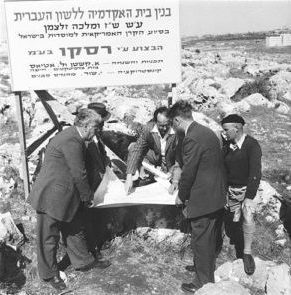
The Language Committee, during its tenure, at times considered the possibility of creating a research academy, but the idea never came to fruition. Shortly before the founding of the State of Israel, the members of the Committee decided at last to establish an academy of the Hebrew language, hoping that the new body – which would replace the Committee – would be an official state institution with a mandate to set standards for Hebrew in tandem with research. In October 1948, a committee comprised of leaders and functionaries of the Language Committee was appointed to prepare the formation of the new institution. In January 1949 a public assembly convened to announce its establishment in the presence of Prime Minister David Ben-Gurion; but only in August 1953 did it actually happen, when the Knesset passed the Law of the Supreme Institution for the Hebrew Language, חֹק הַמּוֹסָד הָעֶלְיוֹן לַלָּשׁוֹן הָעִבְרִית, תשי"ג–1953. The main reason for the delay, it seems, was contention about the institution’s name: the members of the Language Committee insisted upon the word akademya (‘academy’); Ben-Gurion objected to the use of a foreign word. In the end, the law specified that the institution would name itself.
The first 15 members of the Academy were chosen in November 1953. In short order they decided upon the name Ha'Akademya LaLashon Ha'Ivrit, the Academy of the Hebrew Language, and, as directed by law, drafted our charter. The charter spells out how the Academy operates, chooses new members, etc. In 2006 the Academy adopted a new charter reflecting changes in our operation over the preceding half-century. Over the years the charter has also undergone more minor revisions, both before and after 2006. Learn more (in Hebrew).
Since our founding, we have published the Academy’s deliberations and decisions in the multivolume Proceedings of the Academy of the Hebrew Language (in Hebrew); Academy decisions appear also in the official gazette of the State of Israel. As for the Academy’s lists of Hebrew terms – for decades we continued to publish them in print, either in the journal Lešonenu or in stand-alone dictionaries; since the rise of the internet, we have shifted to publishing many of them online only, in our database of Hebrew terms. The database, searchable by list, topic, term, English or Hebrew word, and Hebrew root, includes over a century of Hebrew terms – the fruits of the labor of both the Academy and the Language Committee.
Initially we did not have a home of our own: the academic secretariat and the researchers staffing the nascent Historical Dictionary Project worked in two separate rental apartments; a rented storage space elsewhere housed our publications; and meetings of the plenum and committees took place in the home of an Academy member or in a venue rented for the occasion. In 1955 the Hebrew University of Jerusalem granted us a plot of land on its Giv'at Ram campus, and the following year we held a nationwide public competition to design the Academy’s home; we inaugurated the building in 1959 and commemorated the event with a booklet (in Hebrew, with photos) recording the events of the dedication ceremony. Our home was one of the first buildings erected on the Hebrew University campus at Giv'at Ram.
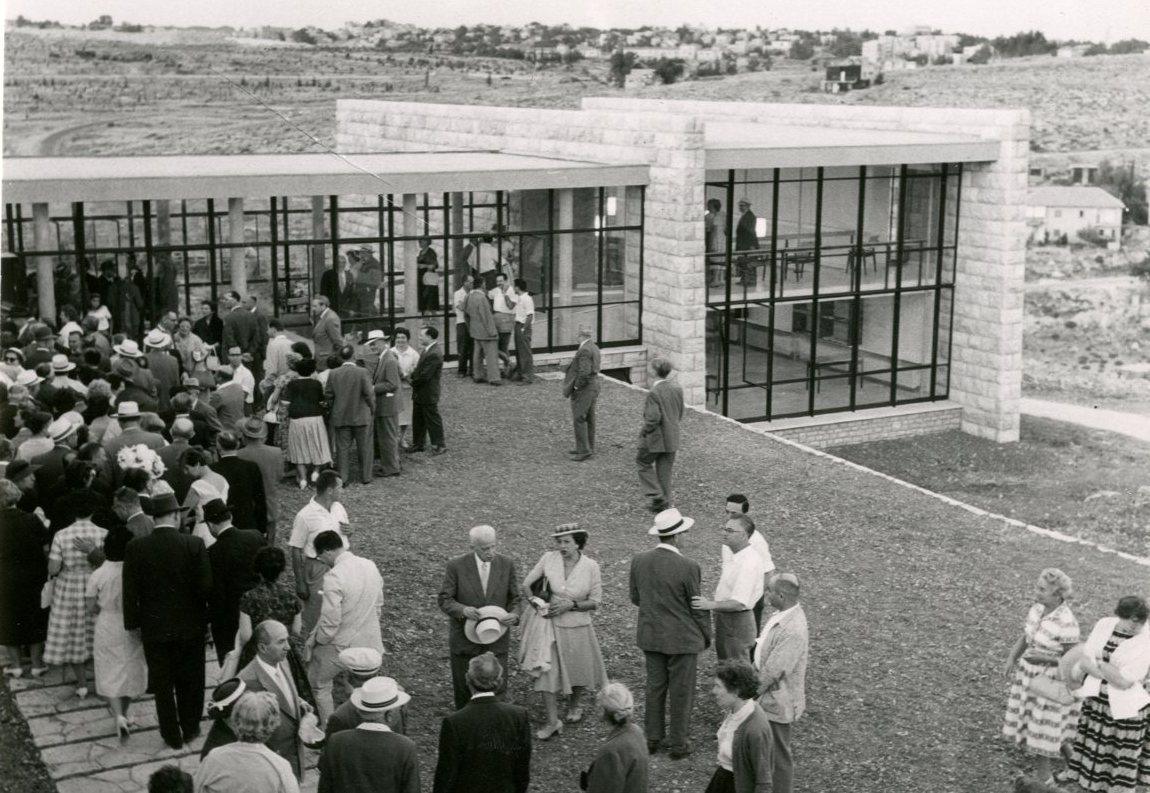
Above: the dedication of the Academy’s home, May 27, 1959. Above right: the site before construction. Below: Rear view of the building in 2013, after renovations.

A Historic Government Decision
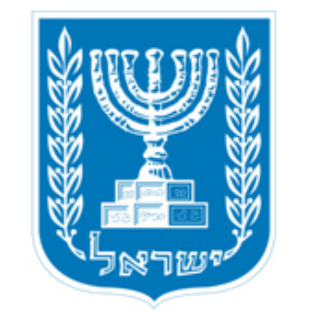
The Israeli government, at a cabinet meeting in November 2012, resolved to establish in Jerusalem a national seat for the Hebrew Language, home to both the Academy of the Hebrew Language and a new Hebrew museum – the first museum ever devoted to the history of the Hebrew language. The center promises to become a national cultural landmark attracting many visitors from Israel and from abroad.
The government decision allotted funds to support the planning stage and established a steering committee to oversee and guide the project. The steering committee consists of representatives of various government ministries and of other national and municipal bodies, led by the president of the Academy or by a representative of the president. Prof. Moshe Bar-Asher, president of the Academy at that time, became the first chairperson of the steering committee and took charge of coordinating the overall effort in cooperation with the Office of the Prime Minister and other government offices, the Jerusalem municipality, the World Zionist Organization, and donors. He also coined a new Hebrew word to designate the Academy’s future home: מִנְוֶה (minve), derived from the word נָוֶה (‘beautiful, pleasant; home, abode’); מִנְוֶה belongs to the same pattern as the nouns מַחֲנֶה (‘camp’) and מִצְפֶּה (‘lookout, observatory’).

